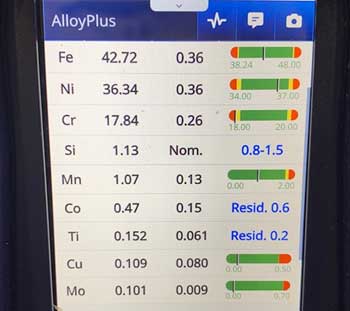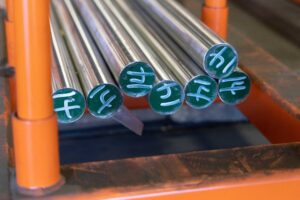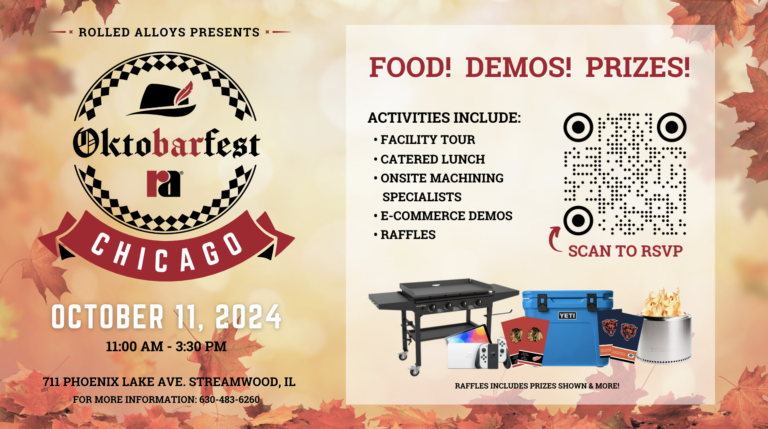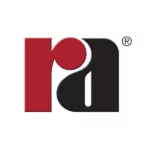Positive material identification (PMI) has become more prevalent and practical in recent years. The development of portable X-ray fluorescence (XRF) units using X-ray tubes instead of isotopes has made it easier to verify alloys at the time of final packaging and shipment, at receiving, and in the field.
Portable optical emission spectroscopy (OES) instruments have also become affordable, which permits analysis of even lower molecular weight alloying elements like carbon. However, the most accurate analyses of carbon, nitrogen, and sulfur are still obtained by combustion techniques.
Testing protocols range from performing a spot check on a heat lot of material to obtaining a complete chemistry for every piece. While many of these instruments have exceptional accuracy for portable hand-held units, they cannot match the accuracy of more sophisticated stationary units found in most test laboratories or steelmaking facilities. These limitations should be considered when establishing acceptance criteria. For product analyses, a chemical analysis check to verify the chemistry of a final product using a stationary unit, the permissible variations can be found in ASTM and AMS specifications.

In ASTM, this information can be found in standards such as A480 (stainless steel flat products) or A484 (stainless steel bar). AMS specifications 2248 (steels and stainless steels) and 2269 (nickel and cobalt alloys) detail similar allowances. Product analysis allowances are necessary due to the variability during processing and deviations associated with analytical reproducibility. Additionally, product analysis occurs at a different stage compared to a heat analysis, so this can introduce variability as well. Table 1 shows permitted variations for a few critical elements per ASTM A480. It is best to consult the equipment manufacturer for the associated variation pertaining to portable units.

Table 1: Allowable Variations for a few Critical Elements per ASTM A480
Most modern XRF units also calculate a standard deviation, which displays how precise the measurement might be. By taking the standard deviation and tripling it, then subtracting and adding this value from the measurement displayed on the XRF unit, you can determine a 99.7% range that subsequent tests should fall within for a given element. This method gives a reliable way to predict the expected spread of readings. This vast amount of potential variation in the reading often means that an acceptable chemistry might appear outside the permissible range. For this reason alone, portable instruments should be used only to confirm the alloy type and should not be used as a basis for rejection.
There are many other reasons for the variation of results in chemistries when testing in the field. Part geometry and surface condition can be factors. There are many other reasons for the variation of results in chemistries when testing in the field. Part geometry and surface condition can be factors.

Portable instruments do not penetrate below this surface layer, which might be marginally reduced in chromium, molybdenum, or other elements. Removing several thousandths from the surface to expose base material may be necessary to get a more reliable indication. This effect can also be avoided by taking the reading on a freshly cut edge or end. The reported results also need to be adjusted for interference from other elements. As the alloy content changes, the interference on the reading from other elements also changes. The portable instruments have sophisticated algorithms that compensate for much of this interference. This design allows the portable instruments to work on an extensive range of alloys and compositions.
To improve accuracy, stationary laboratory instruments can be recalibrated using standards specific to the composition being examined. Laboratories in producing mills are the most familiar with compensating for these variations with their alloys, which is why even independent laboratories occasionally have difficulty matching the mill’s accuracy.
Rolled Alloys has portable XRF units in each of our facilities, and we perform hundreds of tests every day. These instruments help verify the alloy’s identity. Material acceptance or rejection based on chemical analysis should only be done using certified laboratories with the most sophisticated equipment and techniques for the elements in question. In case of a dispute or disagreement, the producing mill should always be involved. Please contact Rolled Alloys Quality Assurance if you have questions about our PMI procedures or capabilities.
Buy Online Anytime
Our dashboard makes it even easier to shop online anytime from anywhere. Quote, buy, and track 24 hours a day.
E-Services Stocking Programs
Our e-service stocking programs put you in the driver seat by using our customized purchasing options to order your recurring material with ease. Whether you have an internal process for purchasing and receiving in place or maybe looking for solutions to become more efficient, we have a program that will work for you.

Chicago Oktobarfest 2024
Join us for food, demo’s and prizes on October 11th from 11 a.m to 3:30 p.m at 711 Phoenix Lake Ave, Streamwood, Illinois.

High Temperature Strength – An Explanation of Creep and Rupture
High Temperature Strength – An Explanation of Creep and Rupture Back To All Articles Share: More Articles Quote, Buy, Track! We make it easy to

Positive Material Identification (PMI)
Positive Material Identification (PMI) Back To All Articles Share: More Articles Quote, Buy, Track! We make it easy to get instant pricing and purchase your

The History and Uses of AL-6XN®
The History and Uses of AL-6XN® Back To All Articles Share: More Articles Quote, Buy, Track! We make it easy to get instant pricing and

Bar Products: Specifications, Key Processes, and Common Confusions Explained
Bar Products: Specifications, Key Processes, and Common Confusions Explained Back To All Articles Share: More Articles Quote, Buy, Track! We make it easy to get

Chloride Stress Corrosion Cracking (CSCC) in Indoor Swimming Pools
Explore the causes and solutions for chloride stress corrosion cracking (CSCC) in 300 series stainless steels used in indoor swimming pool environments.











